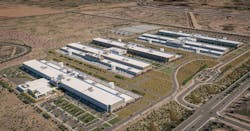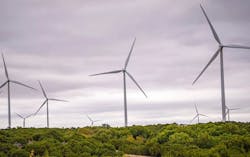Meta Update: Opens Mesa, Arizona Data Center; Unveils Major Subsea Cable Initiative; Forges Oklahoma Wind Farm PPA; More
It's no secret to data center industry watchers how Meta has lately been making major strategic moves to reinforce its digital infrastructure and sustainability commitments, announcing a spate of significant developments.
Most recently, the company officially opened its sprawling data center campus in Mesa, Arizona, a facility designed with cutting-edge efficiency and powered entirely by renewable energy. Simultaneously, Meta has unveiled Project Waterworth, a new subsea cable initiative aimed at enhancing global connectivity and supporting the company’s growing data demands. And, adding to its sustainability portfolio, Meta has also signed a major wind power purchase agreement (PPA) in Oklahoma, further advancing its goal of sourcing 100% renewable energy for its operations.
Together, these initiatives highlight Meta’s aggressive push to scale its digital footprint while maintaining a sharp focus on energy efficiency and global network resilience. Industry observers are also watching closely for signs of a potential future reincorporation in Texas, a move that could signal deeper investment in one of the nation’s fastest-growing data center markets.
Let's take a deeper look at some of Meta's latest strategic moves.
Started In 2021, Meta Brings Mesa, Arizona Data Center Online
Meta’s latest data center, in Maricopa County, Arizona, is its 23rd US facility and it’s 27th worldwide data center. The over $1 billion investment will eventually support a campus with five data center buildings, though this first stage announcement points out that only the first two buildings of the planned campus are in service at this point. Information on Meta’s worldwide operational data centers can be found here. Effective January 30th, Meta’s newest data center started serving traffic to its worldwide user base.
Looking to Be a Positive Influence on the Local Community
Rather than the traditional announcements of speeds and feeds, Meta has focused on talking about the community involvement in this data center project. Still only 40 percent complete, the eventual 2.5 million sq ft of data center space will require a significant local commitment with over 2000 construction jobs at peak, and 200 operational jobs already in place supporting the data center campus.
To help ensure that the local community is able to support the data center needs and Meta has issued grants currently totaling $300,000 to the Mesa Community College which is intended to help provide financial support for local residents who wish to enroll to pursue degrees and certificates focused on STEM. Said Mesa Community College President Richard Daniel, Ph.D.:
Meta’s generous contribution supports Mesa College Promise’s vital role in connecting Mesa residents with pathways to higher education and better job prospects. Promise’s recent expansion from high school to include adult learners accelerates building the workforce of tomorrow.
Understanding that a technology and STEM interest needs to start developing in students before they enter college, Meta also helped, with a $75,000 grant, with the creation of digital multimedia center at the local Deseret Ridge Junior High. The multimedia center is equipped to support students interested in learning about and developing technologies such as video game design, digital art, animation, and music production.
Mesa Mayor Mark Freeman has been very supportive of Facebook’s, now Meta, involvement in the community, being quoted at the launch announcement as saying:
Meta has been a tremendous community member from the moment they chose Mesa as their home. To date, they have invested more than $1.3 million in our schools and nonprofits, and their data center presence supports our local economy as well. We couldn’t ask for a better community partner, and we look forward to deepening that relationship in the years to come.
What Technology Commitments Have Been Announced?
Without providing specifics at this time, Meta has reiterated their commitment to be water-positive by 2030 and is currently working on putting hundreds of millions of gallons of water back into the state’s watersheds by supporting 12 regional water conservation and restoration projects that go beyond the local Mesa, Arizona area.
Mesa has also partnered with Salt River Project (SRP), the second largest public power utility in the U.S. and one that is a not-for-profit organization that provides water and power to central Arizona. The support being provided is for three projects that will add 450 MW of new renewable energy in the SRP service area. The data center facility itself is scheduled to achieve LEED Gold certification and has a construction and operational goal to be sustainable and energy efficient, with its energy use planned to be matched with 100% clean and renewable power.
Construction of the Mesa data center is being managed by California based DPR Construction, who has previously built data centers for Meta in locations such as Pineville, Oregon and Forest City, North Carolina. According to the DPR website, the company is currently involved in the construction of three additional Meta facilities, these being the hyperscaler's Fort Worth, Henrico, and Galatin data centers.
Meta's Project Waterworth: Building the Global Backbone for AI-Powered Digital Infrastructure
Also very recently, Meta unveiled its most ambitious subsea cable initiative yet: Project Waterworth. Aimed at revolutionizing global digital connectivity, the project will span over 50,000 kilometers—surpassing the Earth's circumference—and connect five major continents. When completed, it will be the world's longest subsea cable system, featuring the highest-capacity technology available today.
A Strategic Expansion to Key Global Markets
As announced on Feb. 14, Project Waterworth is designed to enhance connectivity across critical regions, including the United States, India, Brazil, and South Africa. These regions are increasingly pivotal to global digital growth, and the new subsea infrastructure will fuel economic cooperation, promote digital inclusion, and unlock opportunities for technological advancement.
In India, for instance, where rapid digital infrastructure growth is already underway, the project will accelerate progress and support the country's ambitions for an expanded digital economy. This enhanced connectivity will foster regional integration and bolster the foundation for next-generation applications, including AI-driven services.
Strengthening Global Digital Highways
Subsea cables are the unsung heroes of global digital infrastructure, facilitating over 95% of intercontinental data traffic. With a multi-billion-dollar investment, Meta aims to open three new oceanic corridors that will deliver the high-speed, high-capacity bandwidth needed to fuel innovations like artificial intelligence.
Meta’s experience in subsea infrastructure is extensive. Over the past decade, the company has collaborated with various partners to develop more than 20 subsea cables, including systems boasting up to 24 fiber pairs—far exceeding the typical 8 to 16 fiber pairs found in most new deployments. This technological edge ensures scalability and reliability, essential for handling the world’s ever-increasing data demands.
Engineering Innovations for Resilience and Capacity
Project Waterworth isn't just about scale—it’s about resilience and cutting-edge engineering. The system will be the longest 24-fiber-pair subsea cable ever built, enhancing both speed of deployment and durability.
Advanced engineering features include:
-
Deep-sea routing at depths reaching 7,000 meters to minimize physical disruptions.
-
Enhanced burial techniques in shallow, high-risk fault zones to protect against damage from ship anchors and other hazards.
These innovations aim to create a robust and secure global data network that can support AI’s increasing infrastructure demands.
Powering the Future of AI-Driven Connectivity
AI is reshaping industries, economies, and everyday life. For AI applications to thrive, the supporting digital infrastructure must be both scalable and resilient. Project Waterworth positions Meta at the forefront of this transformation by ensuring that high-capacity connectivity reaches even the most remote regions.
By enhancing global access to AI technologies and fostering digital equity, Meta’s latest subsea initiative reinforces its role as a leader in building the future of global infrastructure—ensuring no region is left behind in the next wave of technological advancement.
Meta Expands Renewable Energy Commitments with Enel PPA for Oklahoma Wind Power
Meta has also lately been seen deepening its commitment to renewable energy with a new power purchase agreement (PPA) alongside Enel North America. The deal secures 115 megawatts (MW) of wind power from the Rockhaven Wind Farm in Oklahoma, further advancing Meta's ambition to match its global operations with 100% clean and renewable energy.
This agreement marks the third collaboration between Meta and Enel, reflecting the tech giant's sustained focus on decarbonizing its data center operations. The Rockhaven Wind Farm, located in Murray and Carter counties, is a 140 MW project designed to support growing energy demands driven by electrification, data center expansion, and AI-driven workloads.
"As power demand increases due to electrification, data centers, and AI, with nearly 25 years of clean energy leadership, Enel is ready to meet this opportunity with a portfolio of clean power projects and demand response offerings," said Stephen Pike, Head of Enel Green Power North America. "We’re excited to expand our partnership with Meta through our third PPA. Meta has exemplified how the technology sector can build an interconnected future powered by clean energy."
An Ongoing Partnership
The Meta-Enel partnership dates back to 2018, when Enel began supplying clean power from the Rattlesnake Creek Wind Farm in Nebraska, supporting Meta's Sarpy Data Center. Their collaboration expanded in 2023 with another PPA for power from the Alta Farms Wind Farm in Illinois, benefiting the DeKalb Data Center.
"We are thrilled to again partner with Enel to bring renewable energy to the grid," said Urvi Parekh, Global Head of Energy at Meta. "These projects support our regional operations and data centers, as well as our goal to match our electric usage with 100% clean and renewable energy."
For Enel North America, the partnership underscores its growing role in meeting rising corporate demand for sustainable energy solutions. The company has executed over 100 PPAs, representing more than 7.3 gigawatts (GW) of contracted capacity across the U.S. and Canada. Enel's strategic three-year plan includes scaling its renewable portfolio to 11 GW of wind and solar assets while continuing to expand its demand response capacity for improved grid flexibility and reliability.
With North America identified as a key growth market, Enel’s investments reflect broader industry trends, where major data center operators like Meta seek long-term energy solutions to offset rising power demands while advancing sustainability goals. This latest agreement cements both companies' commitment to a cleaner, more resilient energy future.
Meta Considers Reincorporating Somewhere Other Than Delaware
Finally, according to a late January report in the Wall Street Journal, Meta is considering moving its incorporation from the state of Delaware to a location that is potentially more business friendly, after the success of recent shareholder lawsuits against Delaware incorporated companies.
The best known of these suits was a compensation lawsuit against Elon Musk over his $56 billion compensation package. After this lawsuit in Delaware, Musk started moving his company incorporations elseware, including Texas and Nevada.
Last month, Dropbox announced that they had approval from shareholders to move their incorporation to another state. The presumption is that Nevada will be the destination but no formal announcement has been made. Changing state of incorporation is unlikely to have an impact of physical business locations, such as corporate headquarters.
Texas is considered the leading contender for Meta and has recently been pitching businesses on its favorable regulatory and legal environment for businesses incorporated there, highlighting tax advantages and the states concern on issues like corporate governance as being business positive.
Reports are that this is not a recent concern for Meta with discussions being held before the current presidential administration, and its perceived business friendly attitude, came into power. At publication, there was not yet a formal announcement from either company as to their incorporation plans.
NVIDIA founder and CEO Jensen Huang and Meta founder and CEO Mark Zuckerberg here discuss how fundamental research is enabling AI breakthroughs, and how generative AI and open-source software will empower developers and creators. Reuters recently reported that Meta plans to invest between $60 billion and $65 billion in 2025 to enhance its AI and other infrastructure. This year, Meta said it will begin constructing a 2 GW data center using some 1.3 million NVIDIA GPUs.
About the Author

David Chernicoff
Matt Vincent
A B2B technology journalist and editor with more than two decades of experience, Matt Vincent is Editor in Chief of Data Center Frontier.





